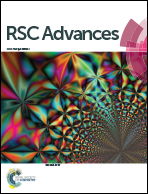Hematoporphyrin and doxorubicin co-loaded nanomicelles for the reversal of drug resistance in human breast cancer cells by combining sonodynamic therapy and chemotherapy†
Abstract
Drug resistance is a main reason for the failure of chemotherapy in cancer treatments. Sonodynamic therapy (SDT) shows great potential for reversing drug resistance of chemotherapy. Here, a sonosensitizer hematoporphyrin (HP) and a chemotherapeutic drug doxorubicin (DOX) were co-loaded into Pluronic F68 nanomicelles for combining SDT and chemotherapy to reverse cancer drug resistance. This multi-functional nanosystem, called HPDF nanomicelle, had a classic “core–shell” structure and a size smaller than 100 nm. In drug-resistant human breast cancer MCF-7/ADR cells that over-express P-glycoprotein (P-gp), HPDF nanomicelles combined with a low-intensity ultrasound could effectively inhibit cell proliferation, promote cell apoptosis and arrest cell cycle at S-phase. Compared free DOX, HPDF nanomicelles significantly reversed drug resistance in MCF-7/ADR cells and the reversal index reached up to 19.0. Apparently, the synergistic effects of combination treatment of SDT and chemotherapy induced by HPDF nanomicelles played important roles in the reversal process against drug resistance. In summary, our study provides a novel strategy for overcoming drug resistance in breast cancer by combining SDT and chemotherapy.


 Please wait while we load your content...
Please wait while we load your content...